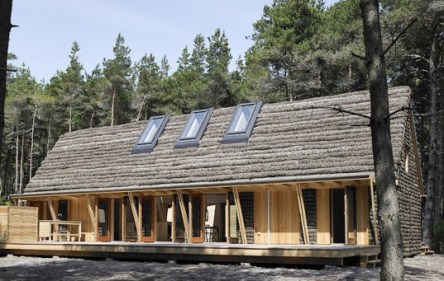Recent decades have brought about numerous developments in the structure of glass: layered, stronger, lighter, and even energy-producing varieties are used in homes and offices around the globe. Getting rid of glass altogether may be the next big advancement in transparent building materials. Glass has natural disadvantages. It is a poor thermal insulator, which requires HVAC systems to work harder, and architects to work smarter. Glass is also a relatively weak material. Wood, on the other hand, is a natural insulator. It moderates indoor temperatures with less drain on the HVAC. Wood is also one of the strongest, renewable, and most versatile building materials around. Wood is so versatile, in fact, that it can now become transparent. Sweden and the Unites States have both made large strides in transparent wood research. In both countries, engineers begin by putting wood through a bath of sodium hydroxide, additional chemicals, and hot water. This process (also used in the production of paper) strips the wood of lignin, the polymer that gives wood its color. The countries vary in what comes next. Lars Berglund, a researcher at Sweden’s KTH Royal Institute of Technology, injects the wood with a polymer. Dr. Liangbing Hu of the University’s Department of Material Science and Engineering injects the channels with an epoxy. Both end with nanoscale tailoring that usher the wood from whitish towards transparent. The resulting products are similar. The wood becomes translucent, up to 85 percent transparent. The final product is also stronger than the original. As researchers refine their technique, they’re getting closer and closer to true transparency. The wood composite has roused interest with several major manufacturers. Both engineers believe that they are only a few short years away from bringing transparent wood products to market. Possible applications for...
Seaweed Siding?
Alt Insulation from the Earth
Building smarter requires low upfront costs, quick returns, and mechanisms to protect the longevity of our investments. A new wave of insulating materials can reportedly do all of that for our properties, so why haven’t they gained more buzz? Insulation that’s affordably priced, durable, fire resistant, and long-lasting is hard to come by, though not impossible. Seaweed had been used by residents on the Danish island of Læsø for hundreds of years before falling out of fashion. It could be making a comeback in the nation and throughout the world. Læsø’s seaweed cottages of old are reminiscent of scenes from The Hobbit: tiny abodes with low roofs and shady interiors nestled in idyllic forests. Those aren’t the living conditions that many of us face. Fortunately, Realdania has created a modern seaweed material that fits into even the most metropolitan landscape. Why seaweed? Why not? A properly laid seaweed roof or “siding” can last for 100-150 years with basic upkeep, drastically reducing maintenance and replacement costs in comparison to even the best architectural shingles or Hardieplank. Seaweed insulates naturally, comparable to mineral wool, while providing a fireproof, non-toxic, CO2-neutral and easily renewable building material. It’s the sustainable solution that should be a serious competitor but simply hasn’t gained much traction in the States. Part of its unpopularity goes back to the aesthetic. To most, it’s ugly. The traditional thatching techniques—artfully piling and twisting loose seaweed—result in a home fit for Middle-earth. The more modern approach still looks heavy and otherworldly but its presentation is slightly more suitable for modern tastes. It holds promise as an insulating alternative that serves double-duty as an exterior covering. For those who have no interest in the textured appearance of seaweed, Ecovative has introduced a series of Mushroom© Materials to...


